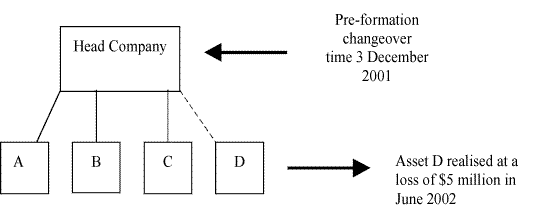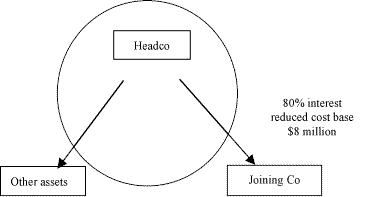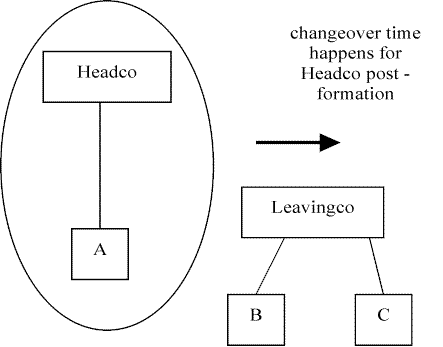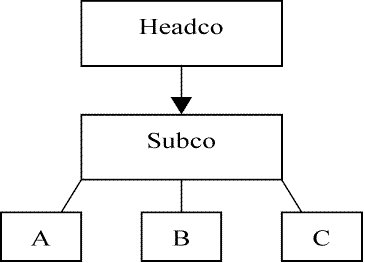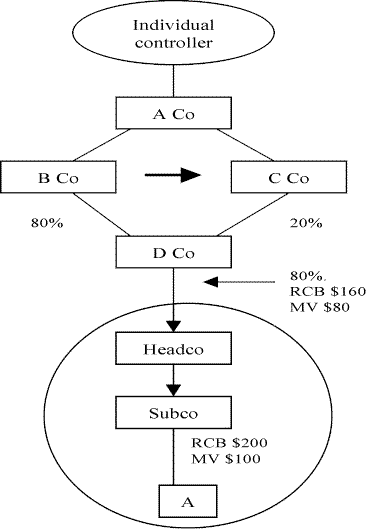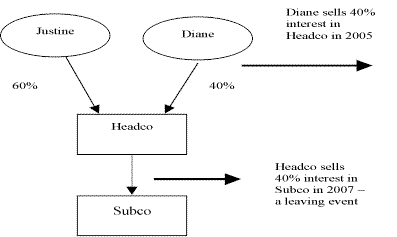Explanatory Memorandum
(Circulated by authority of the Treasurer, the Hon Peter Costello, MP)Chapter 11 - Loss integrity and value shifting interactions with consolidation
Outline of chapter
11.1 This chapter explains consequential amendments to ensure the LIM and GVSR interact appropriately with consolidated and MEC groups. This chapter also explains minor technical corrections and amendments to the LIM and GVSR that help to achieve the same ends.
11.2 These changes focus on the main areas of interaction that have been identified. This is especially so where the existing application of the LIM or GVSR is unclear, or may lead to inappropriate outcomes, where consolidated or MEC groups are involved.
Context of reform
11.3 The LIM and GVSR operate by having regard to losses and value shifts of legal entities in which interests are directly or indirectly held.
11.4The single entity rule means that the LIM and GVSR have no impact for interests within consolidated and MEC groups during consolidation. Loss and value shifting integrity issues are addressed by the leaving tax cost reconstruction rules for such interests (e.g. under Division 711). The single entity rule will not make direct or indirect interests held by non-group members in a consolidated or MEC group subject to the provisions of Part 3-90 (consolidated groups). Accordingly, these interests will continue to be subject to the LIM, GVSR or the loss reduction method (as explained in this chapter).
11.5 Further, this bill contains provisions that deal with loss integrity issues that may arise on formation of a consolidated or MEC group, on the entry of members, and on their leaving.
11.6 Amendments are needed to ensure that the integrity of the LIM and GVSR is substantially retained in all of these circumstances.
| LIM | Key features and effects |
|---|---|
| Single entity rule applies in respect of Subdivisions 165-CC and 165-CD. (Note: A similar rule is not needed for Subdivision 170-D.) | Only the head company can have a changeover or alteration time. Realised and unrealised losses are taken to be in the head company. |
| Subdivision 165-CC in relation to the formation of (and entry into) consolidated and MEC groups. | Same business testing for trial year. If test failed, reductions for calculating allocable cost for membership interests or intragroup debts. Loss denial pools with tagged Subdivision 165-CC assets and Subdivision 170-D amounts. |
| Subdivision 165-CC on leaving from consolidated and MEC groups | Same business testing for the head company on leaving. If test failed, reduce adjustable values of assets to market, or to nil (to save compliance costs). Loss denial pool in leaving entity (in some cases). |
| Subdivision 165-CD in relation to leaving from consolidated or MEC groups. | Revised alteration times based on the head company's reference times and ownership profiles. Otherwise, broadly normal application of Subdivision 165-CD having regard to unrealised losses in leaving entity, or reduction of adjustable values of interests to nil (to save compliance costs). |
| Subdivisions 165-CC and 165-CD during consolidation. | Broadly normal operation modified by extended single entity rule and loss reduction method for interests other than those in the head company of a consolidated group, or in the top company for the MEC group or that are pooled interests. For Subdivision 165-CD and MEC groups, the adjustments for pooled interests are modified, and there are additional alteration times. |
| GVSR | |
| Application of the single entity rule for the purposes of Divisions 723, 725 and 727 | The head company is the relevant entity in respect of group dealings and transactions with external parties. |
| Division 727 during consolidation. | Broadly normal operation modified by an extended single entity rule and the loss reduction method for interests other than those in the head company of a consolidated group, or in the top company for the MEC group or that are pooled interests. For MEC groups, the adjustments for pooled interests are modified. |
| New law | Current law |
|---|---|
| Interaction of LIM and GVSR with consolidated and MEC groups modified or clarified in certain aspects. | Interaction of LIM and GVSR with consolidated and MEC groups either unclear, or inappropriate, in certain aspects. |
| Loss reduction method applies where interests are not susceptible to the underlying methodologies of the LIM or GVSR. | No loss reduction method applies. |
Detailed explanation of new law
11.7 This explanation of the amendments in this chapter is in 8 parts:
- •
- Subdivision 165-CC consequences when an entity becomes a member of a consolidated group or MEC group (paragraphs 11.8 to 11.38);
- •
- Subdivision 165-CC consequences when an entity leaves a consolidated group or MEC group (paragraphs 11.39 to 11.66);
- •
- Subdivision 170-D interaction with Subdivision 165-CC modifications (paragraphs 11.67 to 11.72);
- •
- Subdivision 165-CC in relation to interests in a consolidated group or MEC group (paragraphs 11.73 to 11.82);
- •
- Subdivision 165-CD consequences where an entity leaves a consolidated group (paragraphs 11.83 to 11.93);
- •
- Subdivision 165-CD and Division 727 in relation to interests in a consolidated group or MEC group (paragraphs 11.94 to 11.145);
- •
- LRM (paragraphs 11.146 to 11.169); and
- •
- minor consequential amendments and technical corrections to the LIM and the GVSR (paragraphs 11.170 to 11.175).
Subdivision 165-CC
Subdivision 165-CC - formation of a consolidated or MEC group, or on entry of a subsidiary member
11.8 Broadly, if a company does not satisfy the same business test, Subdivision 165-CC may deny capital losses or deductions (or in some cases cause assessable income to be included) after a change of the company's ownership or control (a changeover time) in respect of assets owned by the company at that time, or in respect of certain deductions or losses deferred under Subdivision 170-D at or before that time. Subdivision 165-CC will only have that effect to the extent of the company's RUNL (if any) in respect of that changeover time.
11.9 Broadly, the same business test requires that the business immediately before the changeover time is compared with the one carried on throughout the income or gain year in which the loss or deduction is claimed or offset.
11.10 Where a company (whether the head company or subsidiary) has had a changeover time before or at consolidation, such testing is not feasible once the group is formed because the business of the company before consolidation is not comparable with the business of the consolidated group.
11.11 In broadly the same way as this issue is addressed for realised losses (see Subdivision 707-A), the modified rules under Subdivision 715-A for Subdivision 165-CC unrealised losses will require same business testing having regard to a 'trial year' before consolidation. The 'trial year' is defined in section 707-120 and is usually the year starting 12 months before the joining time and ending just after the joining time. It is assumed that the entity carried on at and just after the joining time the same business that it carried on just before the joining time (see subsection 707-120(3)). [Schedule 7, item 1, paragraphs 715-50(1)(d), 715-55(1)(d), 715-60(1)(d) and 715-70(2)(c)]
11.12 If the modified same business test is passed, there are no further implications in respect of the pre-consolidation changeover time for Subdivision 165-CC tagged assets that become part of the consolidated or MEC group (or are membership interests or debts in group members). [Schedule 7, item 1, section 715-25]
11.13 If the test is failed, however:
- •
- there may be a write-down to market value (to the extent of the entity's RUNL) of membership interest or intra-group debt cost amounts used for working out step 1 or step 2 amounts of allocable cost under Division 705 (see sections 705-65 and 705-75) - this is to prevent such amounts inappropriately being 'pushed down' onto the tax values of assets which will not carry the Subdivision 165-CC 'tag' of the membership interest or debt; and/or;
- •
- other Subdivision 165-CC tagged assets may be allocated to 'LDP's' which operate similarly to assets tagged to RUNL's in Subdivision 165-CC by reducing realised deductions and losses to the extent of loss denial balance referable to the pool (except that, in the case of an LDP and loss denial balance, there is no further same business testing - that test already having been failed). Asset valuation and removal of losses on tagged assets at consolidation would have removed the need for LDP's, but would be inconsistent with the approach on transition which allows the assets of chosen transitional entities to retain their existing tax values. For these cases, the Subdivision 165-CC policy objects are achieved by the use of LDP's.
11.14 There are also additional rules in Subdivision 715-D for Subdivision 165-CC tagged assets being deferred deductions and other amounts under Subdivision 170-D (see paragraphs 11.67 to 11.72 for more detailed discussion).
11.15 There are 2 common threshold conditions before Subdivision 715-A is activated.
11.16 The company must have a residual unrealised net loss in respect of the most recent changeover time for the company. This is called a final RUNL . [Schedule 7, item 1, section 715-35 and item 21, subsection 995-1(1)]
Subdivision 165-CC tagged asset
11.17 The company must have at least one Subdivision 165-CC tagged asset . This is, broadly, an asset taken into account for the most recent changeover time for the company that is still held by the company or is a Subdivision 170-D amount taken into account under paragraph 165-115A(1A)(b) that has not been recognised by the company before consolidation. [Schedule 7, item 1, section 715-30 and item 15, subsection 995-1(1)]
11.18 Assets not covered by Subdivision 165-CC are not Subdivision 165-CC tagged assets. These include assets acquired since the most recent changeover time, or assets acquired for less than $10,000 where the company has made the choice to exclude these under subsection 165-115A(1B). There are no Subdivision 165-CC tagged assets, and therefore no ongoing implications on consolidation, for a company that met the maximum net asset value test for the changeover time. [Schedule 7, item 1, paragraphs 715-30(d) and (e)]
11.19 Table 11.1 shows the implications for particular entities that become a member of a consolidated or MEC group in respect of Subdivision 165-CC tagged assets where the same business test is failed.
11.20 It is important to note that where the legislation refers to an entity 'joining' a consolidated or MEC group, this will generally apply equally to a formation case (where the 'joining' is on formation) or a case where an entity 'joins' an existing group, unless the context clearly indicates otherwise.
| Entity | Possible consequences for entity on formation: | Possible consequences for entity when it joins an existing group: |
|---|---|---|
| Head company |
[Schedule 7, item 1, paragraph 715-15(1)(a), sections 715-50, 715-55 and 715-60] |
[Schedule 7, item 1, paragraph 715-15(1)(b), sections 715-50 and 715-55] |
| A chosen transitional entity (CTE) |
[Schedule 7, item 1, paragraph 715-15(1)(c), sections 715-50, 715-55 and 715-70] |
|
| NCS on formation, or subsidiary joining |
[Schedule 7, item 1, Subdivision 715-D] |
|
[Schedule 7, item 1, sections 715-50 and 715-55, Subdivision 715-D]
11.21 The main case (the head company on formation) is described below (see Diagram 11.1 and the following paragraphs) and variations applying in the other cases are then discussed (see Table 11.1)
11.22 The adjustments that are made in respect of Subdivision 165-CC tagged assets of the head company where the SBT is failed in respect of a pre-formation changeover time are outlined in Diagram 11.1.
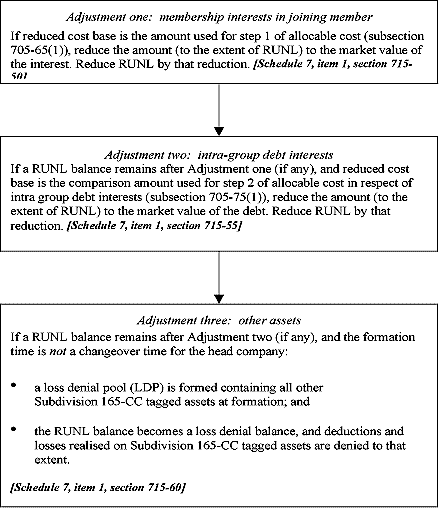
11.23 The adjustments are only required for membership interests and intra-group debt interests whose reduced cost bases are used to 'push-down' allocable costs calculated under steps 1 and 2 (subsections 705-65(1) and 705-75(1)). This means there are no continuing Subdivision 165-CC consequences for a head company's membership interest or intra-group interest in a non-chosen subsidiary. [Schedule 7, item 1, subsections 715-50(3) and 715-55(3)]
11.24 Determining the allocable cost amount to be used already requires that the market value of the membership interest be known and compared with its cost base or reduced cost base to determine whether cost base, market value or reduced cost base is relevant (see subsection 705-65(1)).
11.25 The need for an adjustment must still be determined even if the interest is a relevant equity or relevant debt interest in a loss company that had an alteration time under Subdivision 165-CD at the same time as the company holding the interest had its most recent changeover time, although any Subdivision 165-CD adjustment may effectively reduce or eliminate the need for a further reduction in the reduced cost base of the interest on consolidation.
11.26 If the formation time is not a changeover time for the head company, and there are remaining Subdivision 165-CC tagged assets held by the head company and a balance in the RUNL, a LDP is formed. (If the formation time is a changeover time for the head company, there is a fresh application of Subdivision 165-CC for the assets). [Schedule 7, item 1, subsection 715-60(1)]
11.27 The LDP contains all of the remaining Subdivision 165-CC tagged assets held by the head company. The loss denial balance is equal to the final RUNL (as reduced by Adjustments one and two). [Schedule 7, item 1, subsection 715-60(2) and items 22 and 23, subsection 995-1(1)] .
11.28 If Subdivision 170-D has applied to the head company, there may also be implications (discussed in paragraphs 11.67 to 11.72).
Example 11.1
On 3 December 2001, the Head company had a changeover time under Subdivision 165-CC. It calculated an unrealised net loss of $10 million and the following assets were held at the changeover time:
Asset Reduced Cost base Changeover time market value A $10 million $8 million B $5 million $3 million C $4 million $3 million D $6 million $1 million
On 1 July 2002, the Head company and its subsidiaries form a consolidated group, and there is no new changeover time for the Head company or its subsidiaries at that time. The Head company still holds Assets A, B and C at that time. These are not membership interests or intra-group debts. Asset D was disposed of in June 2002 for its 3 December 2001 market value (i.e. for a capital loss of $5 million), and the RUNL balance became $5 million at that time.
Upon consolidating, the Head company must determine whether the same business test is passed for the trial year period. If it is, then there are no further implications for the group in respect of the 3 December 2001 changeover time.
If the same business test is failed, the Head company will have a LDP with a loss denial balance of $5 million. Assets A, B and C will be Subdivision 165-CC 'tagged' assets to that pool. If, for example, Asset A is then realised for a $2 million capital loss, that loss will be denied and the pool will be reduced to $3 million. (There is no further same business testing as that test has already been failed).
If Asset C were instead a membership interest in a non-chosen subsidiary that formed part of the group, and its reduced cost base were used for determining the allocable cost (because the interest had a reduced cost base of $4 million and a market value of $3 million at formation), then the reduced cost base for subsection 705-65(1) purposes would be reduced to $3 million and the RUNL would be reduced to $4 million. This would then form the balance of the LDP referrable to Assets A and B.
11.29 The formation and application of LDPs is considered further in paragraphs 11.64 to 11.66.
Chosen transitional entity cases - formation
11.30 The rules apply in the same way as described above to a subsidiary entity that is a CTE when a consolidated group forms.
11.31 Adjustments are made in respect of reduced cost bases of membership interests and intra-group debt interests that form part of the allocable cost in respect of the assets of NCS's.
11.32 If a RUNL balance remains after any such adjustments, a separate LDP in respect of each subsidiary is created in the head company. Whilst a single pool may have been simpler, it could have disadvantaged groups by subjecting certain realised losses to loss denial that would not have happened if the companies had remained separate entities. [Schedule 7, item 1, section 715-70]
Non-chosen subsidiaries - formation
11.33 For a subsidiary entity that is a NCS, the approach for the head company formation case applies with the following modifications:
- •
- adjustments one and two are not relevant (because 'push-down' is assumed to address the problem in most cases); and
- •
- adjustment three may apply, but only Subdivision 170-D amounts that have not revived are placed in the LDP (see paragraphs 11.67 to 11.72). The loss denial balance is the final RUNL for the subsidiary entity.
11.34 There are no consequences for the Subdivision 165-CC tagged assets of the joining entity that are membership or intra-group debt interests in another subsidiary member because higher level push-down of allocable cost is assumed to have addressed any integrity issue in most cases. Equally, if entities below the NCS are CTE's, membership interests or debts owned by the NCS in the CTE are not relevant in consolidation cost setting for that entity.
11.35 There are also no consequences for the other assets of the NCS. Testing on formation, except where there are Subdivision 170-D amounts, is not needed to preserve the integrity of the Subdivision 165-CC rules, as the push-down of allocable cost from the head company is assumed to remove the integrity problem in most cases. [Schedule 7, item 1, subsections 715-50(3), 715-55(3) and 715-70(1)]
Head company - subsidiary joining
11.36 There may be Subdivision 165-CC consequences for the head company of an existing consolidated group or MEC group, if a subsidiary entity joins the group and a membership or intra-group debt interest, whose reduced cost base is used for allocable cost purposes, was a Subdivision 165-CC tagged asset for the most recent post-formation changeover time for the head company. There could also be implications for Subdivision 170-D amounts of the subsidiary.
11.37 For these cases, the rules as for a head company formation case apply, with the following modifications:
- •
- the trial year for the head company SBT testing ends immediately after the joining time for the joining entity and starts 12 months before that time - the same business is taken to be carried on at, and immediately after joining as was carried on immediately before joining;
- •
- adjustments one and two only are relevant; and
- •
- the RUNL for the head company is reduced by the amount of any adjustments made.
[Schedule 7, item 1, paragraph 715-15(1)(b)]
Example 11.2
On August 12, 2003, Headco (the head company of a consolidated group) has a changeover time, for which an unrealised net loss of $9 million is calculated. The changeover time assets of Headco include an 80% interest in Joining Co.
In September 2006, Headco acquires the remaining 20% of Joining Co and it joins the consolidated group. Immediately before the joining time, the market value of the 80% interest is $6.4 million.
To work out if there are Subdivision 165-CC implications for allocable cost push-down of the 80% membership interest on entry, the SBT is applied at the time immediately after the changeover time, and for a trial year ending immediately before the joining time for Joining Co.
If the SBT is failed by Headco, then the amount used for the push-down to work out the tax costs of Joining Co's assets is reduced to market value immediately before joining (to the extent of the RUNL for Headco). This means that the amount used for push-down will be reduced by $1.6 million to $6.4 million.
The RUNL is reduced by that amount.
11.38 A subsidiary entity becoming a member of an already formed group cannot be a CTE, and there are possible issues only in respect of Subdivision 170-D amounts that become those of the head company. See paragraphs 11.67 to 11.72.
Subdivision 165-CC - leaving from a consolidated or MEC group
11.39 On the leaving of an entity from a consolidated or MEC group, similar same business testing issues arise as is the case on formation or entry to an existing group, if the leaving entity takes with it assets that are 'tagged' to a RUNL in respect of a changeover time the head company had during consolidation. That is, the business of the group is not comparable with the business of the leaving entity either before, or after leaving.
11.40 There is no same business issue for LDP's because the test has already been failed, but there is a need to ensure that unrealised losses on such assets are subject to potential adjustment after they depart the group.
11.41 There is no issue in respect of Subdivision 170-D deferred loss or deduction amounts because the entitlement to these remains with the head company (see paragraphs 11.67 to 11.72).
11.42 Whether the leaving entity is a company or trust, there are Subdivision 165-CC implications because this is effectively a leaving of 'part' of the head company, notwithstanding that it leaves as a trust. If this were not done, inappropriate advantages could be obtained by releasing loss assets in trusts rather than companies. [Schedule 7, item 1, subsection 715-95(2) and paragraph 715-120(3)(b)]
11.43 There are 2 scenarios to consider in the leaving case:
- •
- the head company has had a changeover time during consolidation, and has an RUNL with assets tagged to it, some or all of which are being taken by the leaving entity. (If the head company has had a changeover time during consolidation, it will have no LDP's in respect of Subdivision 170-D amounts of a joining entity after the changeover time) (paragraphs 11.46 to 11.55);
- •
- the head company has one or more LDP's with tagged assets and some or all of the assets are being taken by the leaving entity (paragraphs 11.56 to 11.57).
11.44 An exception applies if the leaving time is a changeover time for the leaving entity (including where the head company has a changeover time at that time) (see paragraphs 11.58 to 11.61).
11.45 Following the leaving time, there are no continuing implications under Subdivision 165-CC for the head company in respect of the assets that leave the group. [Schedule 7, item 1, section 715-80]
The head company with RUNL and tagged assets
11.46 In this case, there is same business testing for the head company for the 12 months ending just after the leaving time. The SBT is applied to the 12 months immediately before the leaving time (or the period from when the head company came into existence to just after the leaving time if less than 12 months) and the time just before the head company changeover time. [Schedule 7, item 1, subsections 715-95(1) and (3)]
11.47 If the SBT is passed, the assets can go with leaving entity without adjustment (whether for the purposes of the tax costs taken by the leaving entity or those 'pushed up' under Division 711) and there are no ongoing implications in respect of the head company's changeover.
11.48 However, for the future application of Subdivision 165-CC, the leaving entity (if a company) will assume the head company's reference time and all its membership interests will be taken to have been held by the head company from its reference time to immediately before the leaving time. This will ensure that Subdivision 165-CC can apply appropriately at a later time for leaving the company. There are no further implications for a leaving entity that is a trust, because it cannot have a changeover time. [Schedule 7, item 1, sections 715-85 and 715-290]
11.49 If the SBT is failed, the head company will have 3 options:
- •
- option one: reduce the reduced cost bases (and other adjustable values where relevant) of tagged assets that are leaving to nil. There is no reduction in the RUNL balance, because it is not known whether the assets are loss or gain assets (and to allow a RUNL reduction may encourage the taking out of gain assets to dissipate the RUNL pool for the group). This option is simple, involves potentially lower compliance costs, and predominantly affects later losses realised on interests, but it may not be ideal for the group.
- •
- option two: determine the market value of the tagged assets leaving to identify 'loss' assets, and reduce their reduced cost bases (and other adjustable values where relevant) to market value, but only to the extent of the RUNL balance. The RUNL balance is reduced to reflect the reduction. Where more than one loss asset leaves in an entity, the reductions are made to the assets on the basis of their adjustable values: largest to smallest. Where an asset has more than one character, the greatest adjustable value is used to determine the order. This option is more complex, and involves valuation costs, but will usually give a better tax outcome for the group.
- •
- option three: the RUNL effectively leaves with the leaving entity as a loss denial pool (LDP). This option is available only if 'all' remaining assets tagged to an RUNL leave with the leaving entity.
[Schedule 7, item 1, subsection 715-95(3), sections 715-100, 715-105 and 715-110]
11.50 For Options One and Two, the relevant adjustable values that are reduced when an asset leaves the group are:
- •
- for a CGT asset, reduced cost base;
- •
- for an item of trading stock, the most recent opening value or, if acquired during the year when it leaves the group, cost;
- •
- for a depreciating asset, adjustable value; and
- •
- for a revenue asset, the amount that would be subtracted in calculating a profit or loss.
[Schedule 7, item 1, subsections 715-145(1) to (3)]
11.51 In practice, option one may rarely be chosen if the leaving assets consist of a significant number of items of trading stock, or such items are expected to have more than a minimal value.
11.52 The above reductions to adjustable values have effect for cost setting on leaving of interests under Division 711, as they are taken into account for working out the head company's terminating values under section 711-30. [Schedule 7, item 1, subsection 715-145(4)]
Example 11.3
There is a changeover time for Headco (the head company of a consolidated group) in 2003. An unrealised net loss of $2 million is calculated, based on changeover time Assets A, B and C (all held on capital account). At that time, Asset A has a reduced cost base of $5 million and market value of $4 million, Asset B has a reduced cost base of $3 million and market value of $2.3 million and Asset C has a reduced cost base of $0.5 million and a market value of $0.2 million.
Leavingco leaves the group with changeover time Assets B and C (Asset A is still held by the group).
Assuming that the SBT would have been failed, Headco's options are:
- (1)
- reduce the reduced cost bases of Assets B and C to nil and there is no reduction of Heado's RUNL; or
- (2)
- reduce reduced cost bases of Assets B and C to their leaving time market values (assume $2.7 million and $0.2 million respectively). The reductions are therefore $0.3 million for each asset. The RUNL for Headco is reduced by $0.6 million to $1.4 million.
The new reduced cost bases for Assets B and C are used for tax cost setting under Division 711.
The third option is not available as not all of Headco's changeover time assets are held by Leavingco.
11.53 The head company must choose what option is to be used within 6 months of the leaving time, or within a further period allowed by the Commissioner, and provide a notice to the leaving entity. Where no choice is made, the head company will be treated as having chosen the first option. [Schedule 7, item 1, sections 715-175 and 715-180]
11.54 Because the choice may impact on the compliance obligations of the acquirer of leaving entity, this may be a matter of negotiation between acquirer and acquiree during purchase negotiations and the due diligence phase.
11.55 If the third option is chosen, there will be no valuation costs on leaving, but there may be additional compliance costs for the leaving entity as a LDP of tagged assets will need to be maintained. The leaving entity may therefore make a choice (within 6 months of the leaving time) to apply the first or second option instead. [Schedule 7, item 1, section 715-185]
The head company with LDP or LDP's and tagged assets
11.56 The same 3 options as set out above will be available for the head company where a leaving entity leaves with assets tagged to a LDP. [Schedule 7, item 1, subsections 715-120(1) and (3), sections 715-125, 715-130 and 715-135]
11.57 There is, of course, no SBT in this case, because that has already been failed.
Exception: the leaving time is a changeover time for the leaving entity
11.58 If the leaving time is a changeover time for the leaving entity (including where the head company has a changeover time at that time), the above approaches do not apply.
11.59 Whether the leaving time is a changeover time for the leaving entity is determined having regard to the head company's reference time for Subdivision 165-CC purposes and on the assumption that the leaving entity was owned by the head company from its last reference time [Schedule 7, item 1, sections 715-85 and 715-290]. Only a leaving company, not a trust, can have a changeover time.
11.60 If the leaving time is a changeover time for the head company (and therefore for the leaving company), a new RUNL must be determined either for the leaving entity (or for the leaving entity and for the head company in the first case above) and assets tagged appropriately. The reference time will be reset accordingly.
11.61 In respect of the leaving entity, the continuity period will be taken to have ended just after the leaving time, so that the leaving entity will need to satisfy the SBT in respect of the business carried on by the leaving entity at the leaving time. [Schedule 7, item 1, subsection 715-90(2)]
11.62 This treatment is broadly comparable with what would have happened had a subsidiary been sold by a non-consolidated group.
11.63 Diagram 11.2 explains the operation of the Subdivision 165-CC rules where an entity leaves a consolidated group with Subdivision 165-CC tagged assets for a changeover time that happens to the head company. Diagram 11.3 explains the case where an entity leaves a consolidated group with assets that are tagged to a LDP of the head company.
Diagram 11.2: Subdivision 165-CC: The leaving entity leaves with Subdivision 165-CC tagged assets from changeover time that happens to the head company (Headco) (i.e. actual head company RUNL not LDP).
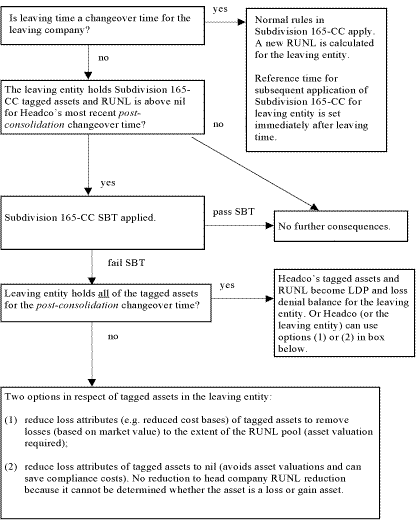
Diagram 11.3: Subdivision 165-CC: The leaving entity leaves with assets tagged to LDP's of head company (Headco).
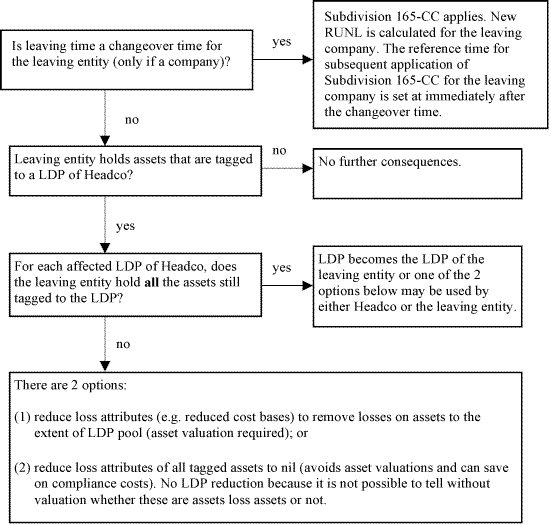
11.64 LDP's are needed to maintain the policy object of Subdivision 165-CC as it is not possible within consolidation to tag an asset or a deferred loss to a specific entity. When a LDP is formed, the assets (and Subdivision 170-D amounts) are tagged to a pool instead.
11.65 It is a 'loss denial pool' because, for each case where it is formed, a changeover time has happened and the SBT has already been failed. Consistent with the policy of Subdivision 165-CC, losses on assets or deferred amounts in a LDP will be denied to the extent of the loss denial balance, and the balance will be reduced by that amount (see Example 11.1). [Schedule 7, item 1, section 715-160]
11.66 Common rules that ensure that LDP's operate consistently with the objects of Subdivision 165-CC are listed below.
| A tagged asset leaves a LDP. | A tagged asset leaves an LDP when:
|
| A LDP balance is less than a:
|
The loss is denied, or the adjustable value is reduced, only to the extent of the remaining amount in the LDP.
The loss denial balance is reduced to nil. |
| More than one tagged asset in a LDP is realised at once. | The entity can choose in what order it reduces the loss denial balance. |
| A LDP ceases to exist. | A LDP ceases to exist if, and only if:
|
[Schedule 7, item 1, subsection 715-130(5), sections 715-155, 715-160 and 715-165]
Subdivision 170-D amounts in respect of Subdivision 165-CC
11.67 Subdivision 715-D deals with Subdivision 165-CC aspects of the treatment of a company's deferred losses under Subdivision 170-D when it becomes a member of a consolidated or MEC group.
11.68 The concept of a Subdivision 170-D deferred loss is defined in terms of the operation of paragraph 170-255(1)(a) of Subdivision 170-D. It refers to a deduction or capital loss that would otherwise have been made that was disregarded [Schedule 7, item 1, subsection 715-310(1)] . Subdivision 170-D deferred losses become those of the head company because of section 701-5 (entry history rule).
11.69 A deferred loss revives when section 170-275 of Subdivision 170-D treats the originating company as making the capital loss or making the deduction. [Schedule 7, item 1, subsection 715-310(2)]
11.70 Subdivision 715-D makes use of the paragraph 715-30(c) reference to a Subdivision 165-CC tagged asset that is, a CGT asset that has a Subdivision 170-D deferred loss because of paragraph 165-115A(1A)(b).
11.71 Broadly, the Subdivision 170-D deferred losses of the head company and subsidiary members are treated similarly to other Subdivision 165-CC tagged assets in that:
- •
- the head company's own deferred losses at formation time are added to a LDP of the head company created under section 715-60 (if one has been created because of other Subdivision 165-CC tagged assets and failure of the SBT), otherwise a LDP is created on an equivalent basis. Its loss denial balance is equal to the company's final RUNL [Schedule 7, item 1, section 715-355] ; or
- •
- a subsidiary's deferred losses (whether on formation or on entry) are treated similarly, but in respect of a separate LDP created in the head company for each affected subsidiary [Schedule 7, item 1, section 715-360] .
11.72 When a Subdivision 170-D deferred loss revives, it is reduced to the extent of any loss denial balance at that time, and the loss denial balance is reduced by the reduction. The balance is applied in the order in which the Subdivision170-D losses revive, and the head company determines the order if 2 or more revive at the same time. A realisation event for Subdivision 170-D purposes takes priority over another application of the pool for the purposes of section 705-130 unless the realisation event happens after the leaving time. [Schedule 7, item 1, section 715-365)]
Subdivision 165-CC in relation to interests in a consolidated group or MEC group
11.73 Some consequential amendments are required so that Subdivision 165-CC can apply to consolidated and MEC groups once they have come into existence.
11.74 To facilitate the application of Subdivision 165-CC and consolidated and MEC groups the single entity rule and entry history rule have been extended. The effect of this is that in most respects the group will be treated as a single company (being the head company of the group) when applying this provision. The head company will be the only entity in the group that will be relevant in terms of Subdivision 165-CC. [Schedule 7, item 2, section 715-75]
11.75 Subdivision 165-CC will largely apply on its normal terms. The head company will be the only group member that can have a changeover time in terms of Subdivision 165-CC.
11.76 The normal rules in Subdivision 165-CC will apply to determine when the head company of a consolidated group has a changeover time. The initial reference time, after a consolidated group comes into existence, is that of the head company.
11.77 The fact that MEC groups have more than one company at the top of their structure (eligible tier-1 companies) means that modifications are required so that Subdivision 165-CC can apply to such groups.
11.78 The way in which changeover times for the head company of a MEC group are determined under Subdivision 165-CC will be modified in the following ways:
- •
- changeover times under section 165-115C or 165-115D - changes in ownership and control of interests in entities between the top company of the MEC group and the eligible tier-1 companies will not be taken into account in working out if the head company has a changeover time (subject to the following dot point) [Schedule 7, item 2, section 719-700] ; and
- •
- the head company of a MEC group will have a changeover time when:
- -
- a potential MEC group ceases to exist, if that group's membership was the same as that of the MEC group;
- -
- there is a change in identity of the top company of the MEC group, but it does not cease to exist; or
- -
- a MEC group ceases to exist because there ceases to be a provisional head company.
[Schedule 7, item 2, subsections 719-705(1) to (3)]
11.79 These modifications are consistent with the COT rules for MEC groups discussed in Chapter 3.
11.80 The first modification has the effect that, in most cases, it is only changes in control and ownership in relation to the top company that are relevant in working out if the head company has a changeover time under section 165-115C or 165-115D. This is appropriate while there is a 100% relationship between the top company and at least one eligible tier-1 company. The initial reference time, for working out when the head company of a MEC group has a changeover time, is when the group came into existence. [Schedule 7, item 2, subsection 719-700(2)]
11.81 The head company of a consolidated or MEC group will work out if it has an unrealised net loss using the normal rules in the Subdivision.
11.82 One effect of extending the single entity rule is that the head company takes into account all group members' CGT assets in working out its unrealised net loss at the changeover time.
Subdivision 165-CD: entry / formation and leaving from a consolidated group
11.83 There are no consequential amendments for the operation of Subdivision 165-CD on entry / formation.
11.84 Where there is an alteration time that has applied before or at consolidation, adjustments made under Subdivision 165-CD may already have the effect of reducing the reduced cost bases of membership interests and intra-group debts relevant for Division 705 allocable cost. If the global method of asset valuation has been used to determine unrealised losses, there is a special rule that applies for allocable cost purposes (see subsection 705-65(3A)).
11.85 For interests in CTE's, the effect of intra-group entity interest reduced cost bases will not be relevant as these will not be pushed down.
Leaving from a consolidated group
11.86 Subdivision 165-CD will broadly have its normal operation on leaving from a consolidated group, but with some important modifications.
11.87 Essentially, the role of Subdivision 165-CD is to make adjustments to prevent duplicate losses being obtained on inter-entity interests where a company has had an alteration time (usually a change of ownership or control), and the company has realised or unrealised losses at that time. Interests of individuals are not affected.
11.88 There is no application of Subdivision 165-CD to interests of subsidiary members of a consolidated group at an alteration time for the head company. This means that there is no mechanism for making adjustments to the reduced cost bases of such inter-entity interests, that, apart from consolidations, would be adjusted to remove duplicate losses based on loss assets in subsidiaries. Where the leaving of a subsidiary entity from a consolidated group does not itself trigger an alteration time, there is a potential for loss duplication, as the adjustable values of unrealised loss assets will be pushed up onto the interests reconstructed under Division 711.
11.89 Example 11.4 explains how the non-application of Subdivision 165-CD to the cases can lead to inappropriate loss duplication.
Example 11.4
Note: 'RCB' means 'reduced cost base' and 'MV' means market value.
A Co (not the head company of a consolidated group) has 3 wholly-owned subsidiaries - B Co and C Co held directly, and D Co held indirectly. D Co has an 80% (controlling) interest in Headco, the head entity of a consolidated group.
B Co transfers its 80% interest to C Co. This causes an alteration time (but probably not a changeover time because of the saving rule) for D Co and Headco.
Headco has only one asset, and that asset has an unrealised loss of $100. Subdivision 165-CD adjustments would be made to all of the entity interests above Headco.
However, no adjustment is made for Headco's shares in Subco. (If these entities had not been consolidated, there would have been a reduction in the RCB of Headco's shares in Subco by $100, eliminating the duplicate loss).
If Subco leaves the group with a 'fresh' ownership profile and this leaving would not itself give rise to an alteration time (e.g. a sale of 5%). Headco's reduced cost base for membership interests in Subco will be reconstructed (based on Division 711) at $200.
This would be inappropriate, and would mean a loss of integrity in terms of what is achieved currently by Subdivision 165-CD.
11.90 The integrity of Subdivision 165-CD is achieved in a consolidation leaving environment by:
- •
- modifying the application of Subdivision 165-CD to ensure that post-formation changes in the ownership profile of the head company are effectively accounted for when a company leaves the group; and
- •
- applying Subdivision 165-CD adjustments when the cost for membership interests for a leaving entity that is a trust is being set.
11.91 The way this is achieved is set out in Tables 11.2 and 11.3.
| Where | These are the consequences on leaving | The leaving entity's reference time is |
|---|---|---|
| Leaving entity is a company | ||
| Leaving time would be an alteration time for the leaving entity based on the head company's reference time (immediately after its last alteration time during consolidation if any, otherwise formation time), based on the assumptions in section 715-290 (see paragraph 11.93).
See Examples 11.5 and 11.7. [Schedule 7, item 1, section 715-245] |
Leaving time is an alteration time for leaving entity.
Leaving entity is a loss company if it has an adjusted unrealised loss on leaving assets. Unrealised losses calculated as if leaving entity had no previous alteration times. Adjustments as outlined in table below. |
Just after the leaving time. |
| The head company has had an alteration time during consolidation but leaving time is
not
an alteration time in respect of the head company's reference time for the leaving entity, based on the assumptions in section 715-290. See example 11.6.
[Schedule 7, item 1, section 715-250 |
As above, except only unrealised losses accruing to the head company's last alteration time captured.
Adjustments as outlined in table below. |
Reference time of leaving entity set to the head company's reference time (after its last alteration time). |
| The head company has not had an alteration time during consolidation and the leaving time not an alteration time with respect to the head company's formation time, based on assumptions in section 715-290. See example 11.8.
[Schedule 7, item 1, section 715-260] |
No alteration time for leaving entity. | Reference time is just after formation time. |
| Leaving entity is a trust | ||
| Leaving entity is a trust.
[Schedule 7, item 1, section 715-270] |
Alteration time.
The leaving trust is taken to be a loss company if it has an adjusted unrealised loss based on leaving assets. Adjustments as outlined in table below. |
No further application of Subdivision 165-CD. |
| Option that may be chosen by the head company | Consequences for membership interests in leaving entity (for CGT assets, reduced cost bases, trading stock values, and revenue asset costs) (Note. For intra-group liabilities, market value of the corresponding asset applies - see subsection 711-45(4)) |
| First Option: reduce tax cost setting amounts to nil.
[Schedule 7, item 1, subsections 715-255(2) and 715-270(6)] |
Tax cost setting amount is reduced just before the leaving time to nil.
(This is a compliance cost saving measure, as no valuations will be required at the leaving time. It may not be ideal for the group.) |
| Second Option: work out modified Subdivision 165-CD adjustments and reduce the amount pushed up on leaving.
[Schedule 7, item 1, subsections 715-255(3) and 715-270(7)] |
Tax cost setting amount just before leaving time is reduced by Subdivision 165-CD adjustment calculated using the non-formula approach in subsection 165-115ZB(6) on the assumptions that:
|
11.92 The head company must make the choice of method within 6 months of the leaving time or a further time allowed. If no choice is made, the head company is taken to have chosen the first option. [Schedule 7, item 1, subsections 715-255(4), 715-255(5), 715-270(8) and 715-270(9)]
11.93 Generally, for the purposes of applying the rules discussed in Tables 11.2 and 11.3, and for the continuing application of Subdivision 165-CD for the leaving company, the membership interests in a leaving entity are treated as having been beneficially held by the head company from the relevant reference time to immediately before the leaving time. [Schedule 7, item 1, section 715-290]
Example 11.5
Headco elects to consolidate the Head Group in 2003, including its wholly-owned subsidiary Sub Co. The original cost of Headco's investment in Subco ($10 million) is pushed down onto Subco's formation time Assets A and B.
There is an alteration time for Headco on 2 May, 2006. On 11 November 2011, Subco leaves the group with Assets B and C when 60% of the interests in Subco are sold by Headco.
The data relevant to the 2006 alteration time and the 2011 leaving time are as follows.
Asset Reduced cost base Market value at alteration time (2006) Market value at leaving time for Leaving Co (2011) A (disposed of 2008 for $2.5 million) $5 million $2.5 million n.a. B $5 million $ 3.5 million $0.8 million C (acquired 2008) $2.5 million n.a $1.5 million
There is an alteration time for Leaving Co on leaving, based on Headco's reference time (2 May 2006).
There are 2 options for Headco in setting the tax costs for interests in Subco on leaving:
Option 1: the reduced cost base of Headco's interests in Subco is reset at nil on leaving.
Option 2: the tax cost setting amount used to determine the reduced cost base of Headco's interests in Subco (ordinarily $7.5 million) is reduced by the unrealised losses at that time ($4.2 million plus $1 million equals $5.2 million). The tax cost setting amount of $2.3 million is applied across the interests.
The reference time for working out whether Leaving Co later has an alteration time is set at immediately after the leaving company's leaving on 11 November 2011.
Example 11.6
Assume the facts in Example 11.5. Assume however that the trigger that leads to Subco leaving the group is the transfer of 5% of Headco's shares in Subco. There is taken to be an alteration time on leaving.
Both options are available for working out the tax cost setting amount for Headco's interests on leaving.
If the second option is chosen, however, the only leaving assets that are taken into account in working out the adjusted unrealised loss for Subco are those that were held by the group at the earlier alteration time (i.e. Asset B). The adjusted unrealised loss is calculated on the basis of the unrealised loss at that time ($5 million less $3.5 million equals $1.5 million). Therefore the tax cost setting amount on leaving is $6 million.
The reference time for working out when there is another alteration time for Subco is set at immediately after Headco's alteration time (2 May 2006).
Example 11.7
Headco (shareholders Justine 60% and Diane 40%) elects to form a consolidated group in July 2002.
In 2005, Diane sells her 40% interest in Headco. In 2007, Subco leaves the group when Headco sells 40% of the shares to an unrelated party.
As there has not been an alteration time for Headco from the time of formation to when Subco leaves, Headco's formation time ownership profile is used to work out if there is an alteration time for Subco on leaving. On this basis, there is an alteration in ownership, as the only interest in shares maintained is Justine's indirect interest (36%).
The adjusted unrealised loss for Subco is worked out in the normal way (taking into account all leaving time assets). The reference time for working out when a later alteration time happens for Subco is the time immediately after leaving in 2007.
Example 11.8
Assume the facts as in Example 11.7. Assume, however, that Headco sells 10% of the shares in Subco (rather than 40%).
There is no alteration time on leaving. There is no alteration in ownership, as Justine's continuing interests equals 54% of the interests in Subco.
The reference time for working out when Subco has a later alteration time is set just after Headco's formation time. For the period from formation to leaving interests in Subco are taken to be held directly by Headco in Subco.
Subdivision 165-CD and Division 727 in relation to interests in a consolidated group or MEC group
11.94 Some consequential amendments are required so that Subdivision 165-CD and Division 727 can apply to consolidated and MEC groups once they have come into existence. These changes will generally only affect:
- •
- direct and indirect equity or loan interests in the head company of a consolidated group;
- •
- pooled interests in the eligible tier-1 companies of a top company of a MEC group; and
- •
- direct and indirect equity or loan interests in the top company of a MEC group.
11.95 All other direct and indirect equity and loan interests in members of a consolidated or MEC group can be covered by the loss reduction method (see paragraphs 11.146 to 11.169). Specific rules ensure that Subdivision 165-CD or Division 727 do not apply. [Schedule 7, item 1, sections 715-230 and 715-450]
11.96 Subdivision 165-CD adjusts certain equity and debt in a company, to deal with the effect of the company's losses on the interests. The object is to ensure that the company's losses are not duplicated when interests in the company are realised, to the extent that they accrued to the company while the interest was held by the entity.
11.97 In a similar way, Division 727 makes adjustments in relation to equity and loan interests of certain entities in related entities that are involved in an indirect value shift. Adjustments, generally, reflect the market value effects of an indirect value shift that happens while an entity holds such an interest.
11.98 To apply Subdivision 165-CD and Division 727 on their normal terms to a consolidated or MEC group, an entity would require various information, including details of:
- •
- when group member companies have an alteration time;
- •
- whether the group company had realised or unrealised losses at that time (i.e. whether it is a loss company);
- •
- which interests are relevant equity interests or relevant debt interests in the group member loss company;
- •
- the effect of losses on the market values of relevant equity interests or relevant debt interests in the group member loss company;
- •
- when a group member is a losing entity or gaining entity for an indirect value shift;
- •
- chains of ownership of equity and loan interests in such entities, to determine if the ultimate controller or common ownership requirements are met; and
- •
- what effect the indirect value shift had on the market value of such interests.
11.99 Further issues arise in seeking to apply Subdivision 165-CD and Division 727 to MEC groups. These issues relate to the fact that such groups have more than one company at the top of their structures (eligible tier-1 companies). Unlike consolidated groups, where it can often be assumed that things that happen in the group will affect the value of interests in the head company, for MEC groups this is not the case. For example, if a subsidiary member owned by a particular eligible tier-1 company is involved in an indirect value shift with a non-group entity, only the market value of interests in that eligible tier-1 company will be affected.
11.100 Consolidation means that it is not feasible for Subdivision 165-CD and Division 727 to be applied on a basis that would require an examination of transactions or events, and their effects, within the group.
11.101 To facilitate the application of Subdivision 165-CD and the GVSR (Divisions 723, 725 and 727) to consolidated and MEC groups the single entity rule and entry history rule have been extended. The effect of this is that in most respects the group will be treated as a single company (being the head company of the group) when applying these provisions. For example, the head company will be the only entity in the group that will be relevant in terms of Subdivision 165-CD and Division 727. [Schedule 7, item 1, sections 715-215 and 715-410]
11.102 Some of the effects of extending these rules are:
- •
- the head company will be taken to have owned all CGT assets of group members at an alteration time, and to have made any tax loss or net capital loss for the assumed income year ending at that time; and
- •
- the head company will be taken to have provided and received all economic benefits in terms of an indirect value shift.
11.103 The consequential amendments cover situations where a consolidated or MEC group is affected by Subdivision 165-CD (inter-entity loss multiplication).
11.104 A group can be affected by an alteration time under Subdivision 165-CD where the head company has an alteration time. The Subdivision will prevent the duplication of the group's realised and unrealised losses when significant equity and debt interests in the group are realised.
Subdivision 165-CD and consolidated groups
11.105 Subdivision 165-CD will largely apply on its normal terms to consolidated groups. The head company will be the only group member that can have an alteration time in terms of Subdivision 165-CD.
11.106 The normal rules in Subdivision 165-CD will apply to determine when the head company of a consolidated group has an alteration time. The initial reference time, after a consolidated group comes into existence, is that of the head company.
11.107 The head company will also work out if it is a loss company and the amount of its overall loss (if any) using the normal rules in the Subdivision. The individual asset and global methods are both available to work out if the head company has an adjusted unrealised loss.
11.108 One effect of extending the single entity rule is that the head company takes into account all group members' CGT assets in working out its adjusted unrealised loss at the alteration time.
11.109 As mentioned in paragraph 11.105, Subdivision 165-CD will only apply to relevant equity interests or relevant debt interests in the head company of a consolidated group. In general terms, the Subdivision adjusts such interests with regard to the market value effect of the losses making up the overall loss of the head company. The formula and non-formula adjustment methods are available.
11.110 Sections 165-115U and 165-115W of Subdivision 165-CD have double counting rules that apply when the individual asset method is used to work out the adjusted unrealised loss of a loss company. These rules ensure that to the extent an unrealised loss is taken into account at one alteration time for a company, it is not taken into account at a later alteration time. The effect of extending the entry history rule is that the double counting rules can apply.
11.111 Where a company holds an asset at an alteration time before becoming a member of a consolidated or MEC group it will generally not be appropriate for the double counting rules to apply if the head company of the group holds that asset at a later alteration time. This is because Division 705 deals with unrealised losses on assets as part of the cost setting process for assets. [Schedule 7, item 1, section 715-225]
11.112 The exception to this is where on formation of a group the asset is owned by a chosen transitional entity. The double counting rule also needs to apply to assets that the head company owned before it became a group member. In both of these cases Division 705 does not change the tax costs of these assets.
11.113 Applying Subdivision 165-CD to a consolidated group as if it is a single company means that certain losses (e.g. trust losses) that would not normally be covered by the Subdivision are subject to it. This is appropriate because the nature of an entity in a consolidated group is not relevant. What is relevant is that the head entity is a company.
11.114 The application of the LRM (see paragraphs 11.146 to 11.169) to certain interests will mean that some of the relief in Subdivision 165-CD will not be available for those interests - for example, the LRM can apply to less than 10% equity holdings. This is because it is not possible to tell if the loss relates to indirect value shifts or reflects losses in the group.
Diagram 11.4: Subdivision 165-CD and consolidated groups
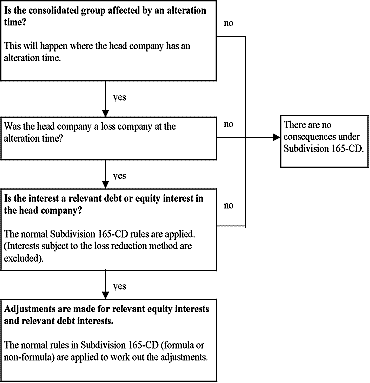
Subdivision 165-CD and MEC groups
11.115 The fact that MEC groups have more than one company at the top of their structure (eligible tier-1 companies) means that additional modifications to those for consolidated groups are required so that Subdivision 165-CD can apply to such groups.
When will the head company of a MEC group have an alteration time?
11.116 The way in which alteration times for the head company of a MEC group are determined under Subdivision 165-CD will be modified in the following ways:
- •
- alteration times under section 165-115L or 165-115M - changes in ownership and control of interests in entities between the top company of the MEC group and the eligible tier-1 companies will not be taken into account in working out if the head company has an alteration time (subject to the following dot point) [Schedule 7, item 2, section 719-720] ;
- •
- the head company of a MEC group will have an alteration time when:
- -
- a potential MEC group ceases to exist, if that group's membership was the same as that of the MEC group;
- -
- there is a change in identity of the top company of the MEC group, but it does not cease to exist; or
- -
- a MEC group ceases to exist because there ceases to be a provisional head company [Schedule 7, item 2, subsections 719-725(1) to (3)] ; and
- •
- the head company will have an alteration time just before a trigger time in paragraph 719-555(1)(a). These times are when:
- -
- one or more eligible tier-1 companies cease to be members of the group; or
- -
- a CGT event happens to one or more reset interests in an eligible tier-1 company [Schedule 7, item 2, subsection 719-725(4)] .
11.117 These modifications are consistent with, and complement, the COT rules for MEC groups discussed in Chapter 3.
11.118 The first modification has the effect that, in most cases, it is only changes in control and ownership in relation to the top company that are relevant in working out if the head company has an alteration time under section 165-115L or 165-115M. This is appropriate while there is a 100% relationship between the top company and at least one eligible tier-1 company. The initial reference time, for working out when the head company of a MEC group has an alteration time, is when the group came into existence. [Schedule 7, item 2, subsection 719-720(2)]
11.119 Alteration times resulting from the first and second modifications will only be relevant for direct and indirect equity or loan interests in the top company of a MEC group that are relevant equity interests or relevant debt interests in the head company of that group just before the alteration time. Only pooled interests in relation to the group are covered by alteration times under the third modification. This treatment complements the COT rules for MEC groups. [Schedule 7, item 2, sections 719-730 and 719-735]
11.120 Membership interests in an eligible tier-1 company of a MEC group are not pooled interests if a member of the group holds them. These interests are not covered by the above modifications because Division 711 sets the tax costs of these interests if the eligible tier-1 company leaves the group.
11.121 The existing Subdivision 165-CD rules on how to work out if a company is a loss company and its overall loss at an alteration time applies, including the individual asset and global methods of working out adjusted unrealised losses.
11.122 The normal reduction and other consequences rules in Subdivision 165-CD will apply if the head company is a loss company at an alteration time and the alteration time is not under the third modification discussed above.
11.123 If it is an alteration time under the third modification, the reduced cost base pooled cost amount is reduced by the amount of the head company's overall loss at the alteration time. The normal rules do not apply. [Schedule 7, item 2, subsection 719-735(2)]
11.124 The requirement for a relevant equity interest to be at least a 10% holding does not apply to pooled interests. This is appropriate given the 100% relationship between the top company and the MEC group.
Diagram 11.5: Subdivision 165-CD and MEC groups
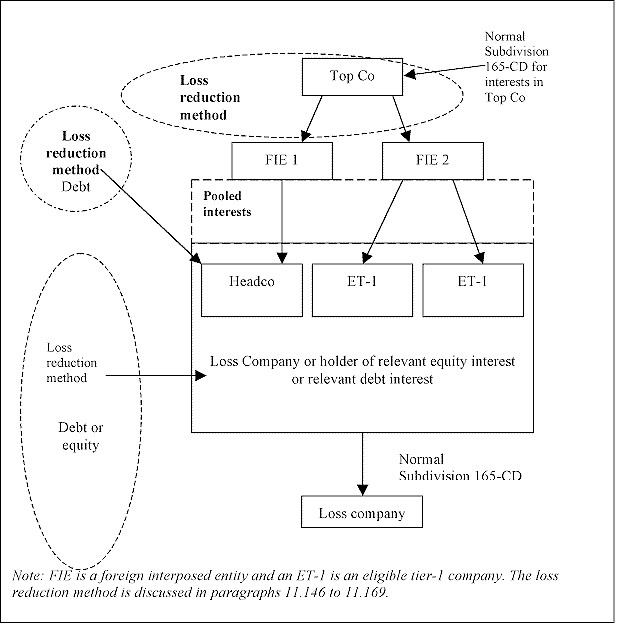
Diagram 11.6: Subdivision 165-CD and MEC groups
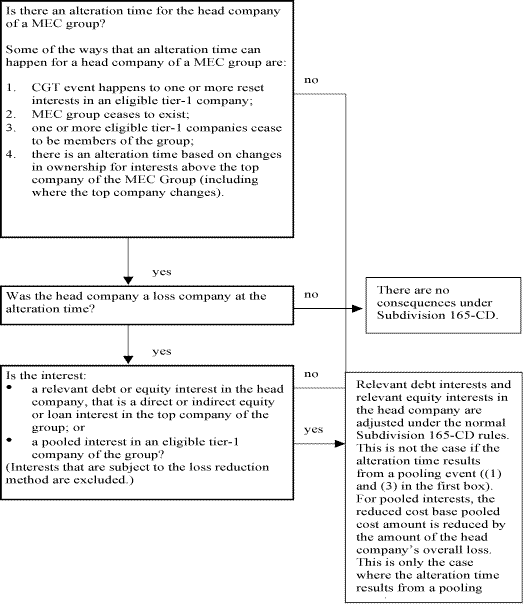
11.125 The consequential amendments also cover situations where a consolidated or MEC group is involved in an indirect value shift under Division 727 (indirect value shifting affecting interests in companies and trusts, and arising from non-arm's length dealings).
11.126 A group can be involved in an indirect value shift where a group member provides, or receives, economic benefits because of a non-arm's length dealing with a related entity that is not a member of the group.
11.127 The rules are required to ensure that the effects of indirect value shifts do not inappropriately distort tax outcomes where one of the entities involved in the value shift is a member of a consolidated or MEC group. For example, if a member of a consolidated group sells a number of assets to an associate of the group for less than market value, this could result in a loss being made when a membership interest in the head company of the group is realised.
11.128 As discussed in paragraph 11.101, the single entity rule and entry history rules have been extended so that the head company is the only relevant group member in applying Division 727 to consolidated or MEC groups.
11.129 The consolidation framework means that it is, generally, not necessary to deal with the effects of indirect value shifts between group members. The effects of such shifts on interests held by one group member in another are generally dealt with by Division 711 or section 701-20 where the later member ceases to be a subsidiary member of the group. The pooling rules in Subdivision 719-K deal with the effect of indirect value shifts within a MEC group on pooled interests.
Division 727 and consolidated groups
11.130 One effect of extending the single entity rule is that the head company of a consolidated group will be the only group member that can be a losing entity or gaining entity in terms of Division 727. This applies from the perspective of the group and affected entities outside of the group.
11.131 Division 727 applies normally in most respects to the head company of a consolidated group. Some points to note are:
- •
- the head company is taken to have provided and received all economic benefits in terms of the Division;
- •
- the control and common ownership tests are applied in the normal way;
- •
- only direct and indirect equity or loan interests in the head company of the consolidated group can be affected interests; and
- •
- adjustments are made with regard to the market value effects of an indirect value shift on affected interests in the head company.
11.132 The first dot point is a consequence of the single entity rule being extended. The third point reflects the fact that direct and indirect equity or loan interests in members of a consolidated group, that are not actually in the head company, are covered by the LRM (see paragraphs 11.155 to 11.163).
11.133 Both the realisation time and adjustable value methods in Division 727 are available to work out the consequences of an indirect value shift involving the head company of a consolidated group. The fourth dot point reflects the fact that both of these methods have regard to the market value effects of the value shift.
Diagram 11.7: Division 727 and consolidated groups
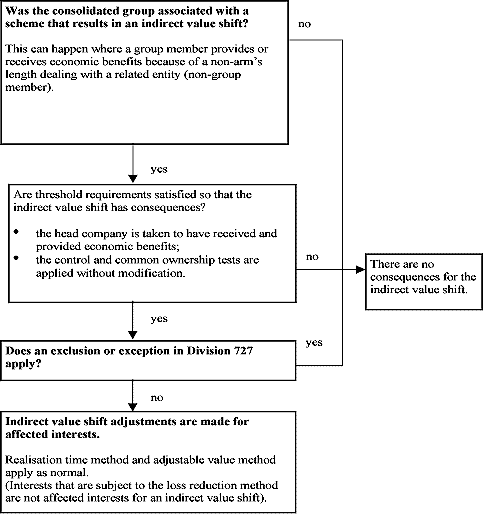
11.134 As for consolidated groups, the head company of a MEC group will be the only group member that can be a losing entity or gaining entity under Division 727.
11.135 In many respects Division 727 applies normally to the head company of a MEC group. Some of the modifications to the operation of the Division are:
- •
- the head company is taken to have provided and received all economic benefits in terms of the Division;
- •
- the only interests that can be affected are:
- -
- direct and indirect equity or loan interests in the top company for the MEC group; or
- -
- pooled interests in eligible tier-1 companies that are members of a MEC group; and
- •
- adjustments are made with regard to the market value effects of an indirect value shift on affected interests in the top company, and pooled cost amounts are adjusted for pooled interests.
11.136 The second dot point notes that only direct and indirect equity or loan interests in the top company for the MEC group and pooled interests can be affected by Division 727 when the head company is involved in an indirect value shift. [Schedule 7, item 2, section 719-755]
11.137 These interests are a subset of direct and indirect equity or loan interests in the eligible tier-1 companies of a MEC group. The full set of these interests are similar in nature to those in the head company of a consolidated group.
11.138 The structure of MEC groups means that direct and indirect equity or loan interests in the top company for a MEC group are indirect equity or loan interests in the head company and other eligible tier-1 companies of the MEC group. Pooled interests are also equity interests in the head company and other eligible tier-1 companies. All other direct and indirect equity or loan interests in eligible tier-1 companies are covered by the LRM.
11.139 There will only be consequences of an indirect value shift for interests in the top company of a MEC group where such interests are affected interests in terms of Division 727. That is, they must be held just before the IVS time by an entity that is related to the head company.
11.140 All other equity or loan interests in members of a MEC group (not eligible tier-1 companies) are also covered by the loss reduction method (see paragraphs 11.155 to 11.163).
11.141 Both the realisation time and adjustable value methods in Division 727 are available to work out the consequences for interests in the top company of an indirect value shift involving the head company of a MEC group. Both of these methods have regard to the market value effects of the value shift and apply whether the head company is a losing entity or gaining entity for the indirect value shift.
11.142 The consequences for pooled interests in eligible tier-1 companies of a MEC group are different. If the head company is a losing entity for an indirect value shift, the cost base and reduced cost base pooled cost amounts are reduced by the amount of the indirect value shift. If the head company is a gaining entity, the pooled cost amounts are increased by the amount of the indirect value shift. The adjustments happen for the first trigger time for the pooled interests at or after the IVS time. [Schedule 7, item 2, subsection 719-755(3)]
11.143 Pooled cost amounts are adjusted in this way because regard cannot be had to which group member was involved in an indirect value shift. Without this information it is not generally possible to tell whether a change in the market value of an interest in an eligible tier-1 company is attributable to the value shift.
11.144 There is no requirement for pooled interests to be affected interests in terms of Division 727. However, in most (if not all) cases they would be affected interests under the Division.
11.145 The normal exceptions and exclusions under Subdivision 165-CD and Division 727 will also generally apply.
Diagram 11.8: Division 727 and MEC groups
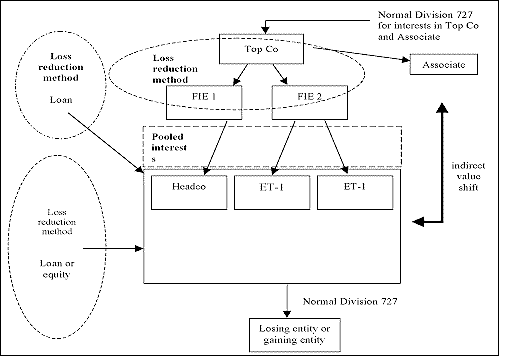
Note: FIE is a foreign interposed entity and an ET-1 is an eligible tier-1 company. IVS is an indirect value shift. The loss reduction method is discussed in paragraphs 11.146 to 11.169.
Diagram 11.9: Division 727 and MEC groups
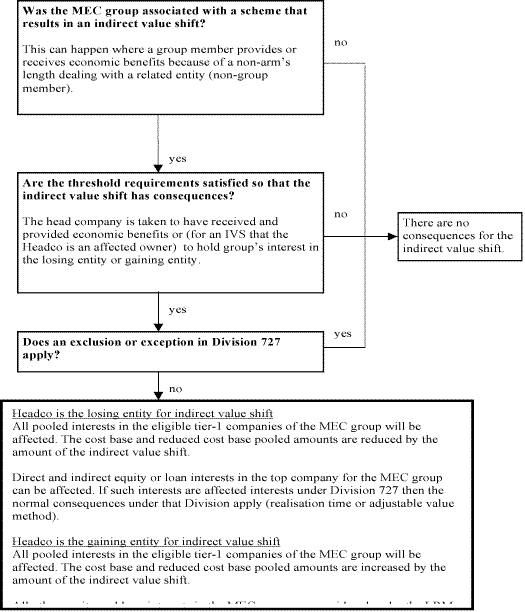
Loss Reduction Method
11.146 In their ordinary operation, the loss integrity measures and Division 727 of the GVSR make adjustments having regard to the market value effect of losses in, or value shifts affecting, an entity in which an interest is directly or indirectly held.
11.147 In the context of consolidated groups, such an application is problematic, especially for interests that are not held directly, or indirectly, in the head company. For example, a debt interest of an 80% associate of the head company in a subsidiary of the group.
11.148 The 'tracing of value' problems are compounded in the case of MEC groups where the head entity will not be a relevant 'top' company which might be expected to reflect the effect of group losses and value shifts.
11.149 If the group were not consolidated, it would be feasible to determine what losses or value shifts were relevant to a subsidiary, and therefore what amounts should be relevant in respect of adjustments for interests held directly or indirectly in that subsidiary. However, in consolidation, the head company is taken to make all the losses and be the relevant entity for value shifts relating to non-group entities.
11.150 It is not considered feasible to require, or to allow, consolidated tax outcomes to be unbundled and recalculated on a legal entity basis for the purposes of applying the value shifting and loss integrity rules to 'external' interests which have some connection with the consolidated or MEC group.
11.151 Thus, it is proposed that certain interests be subject to the LRM in cases where it is not possible to tell whether, and by how much, such interests are affected by a loss or indirect value shift involving the group.
11.152 Broadly, the method will mean that realised losses will be reduced to nil on such interests, unless it can reasonably be shown that the loss is attributable to factors other than group indirect value shifts (internal or external), decreases in the market value of group assets, and group losses.
11.153 The LRM applies to the interest of an entity where:
- •
- the realisation of the interest results in a loss for income tax purposes;
- •
- the interest was an equity or loan interest, or indirect equity or loan interest, in a member of a:
- -
- consolidated group; or
- -
- MEC group;
at some time during the period the entity owned it (some interests are excluded); and
- •
- the entity was the head company of the group, a controller of the head company, or an associate of the head company or such a controller, at some time during the period the interest was owned.
[Schedule 7, item 1, section 715-610 and item 2, section 719-775]
11.154 Generally, where the LRM applies it reduces to nil the loss realised for income tax purposes. [Schedule 7, item 1, subsection 715-610(1) and item 2, subsection 719-775(1)]
What interests are affected by the LRM?
11.155 These rules apply to all direct and indirect equity and loan interests in group members of a consolidated group or MEC group that are not covered by the rules relating to Subdivision 165-CD and Division 727.
11.156 Interests in consolidated groups and MEC groups not covered by the LRM are:
- •
- direct and indirect equity or loan interests in the head company of a consolidated group;
- •
- equity interests that are pooled interests in relation to a MEC group;
- •
- direct and indirect equity or loan interests in the top company for a MEC group; and
- •
- membership interests in, or liabilities owed by, an entity leaving the group.
[Schedule 7, item 1, subsection 715-610(2) and section 715-615 and item 2, sections 719-780, 719-785 and 719-790]
11.157 The last dot point in the above paragraph covers interests where special rules apply when an entity leaves the group. For example, Division 711 covers membership interests in a transitional foreign-held subsidiary.
11.158 Interests affected are generally those in a subsidiary member of a consolidated or MEC group, or in entities (below the top company for a MEC group) with pooled interests in eligible tier-1 companies of the group. For example, loans to subsidiary members of a consolidated group, and direct and indirect interests in the entities with such loans.
11.159 Not only must the realised interest of an entity be one covered by the LRM, but the owner must have a specified relationship to the group. That is, not all interests discussed above will be subject to the LRM.
11.160 For a loss on an interest to be affected by the LRM the owner must have:
- •
- been the head company of the group;
- •
- controlled (for value shifting purposes) the head company;
- •
- been an associate of the head company; or
- •
- been an associate of an entity that controlled (for value shifting purposes) the head company,
at some time during the period the interest was owned.
11.161 This ensures that only interests of entities with an appropriate relationship to the group, or its controllers, are subject to the LRM.
11.162 In practice, this means that interests of the top company for a MEC group, and of entities interposed between it and the eligible tier-1 companies of the group will be covered by the LRM (except for pooled interests). This is appropriate because the top company will control (for value shifting purposes) the head company and other entities will be associates of it or the head company.
11.163 These rules also cover interests in (direct or indirect) transitional foreign-held subsidiaries of a consolidated or MEC group.
Reductions to losses realised on affected interests
11.164 Where the LRM applies it reduces to nil losses realised for income tax purposes when a realisation event happens to relevant interests of entities. Division 977 (realisation events, and the gains and losses they realise for income tax purposes) of the ITAA 1997 provides for when a loss is realised by a realisation event. The main case is where a capital loss is made from a CGT event happening to a CGT asset. There are other realisation events for trading stock and revenue assets.
11.165 The loss is not reduced to nil, or it is reduced to a lesser extent, in some cases. This happens where it can be shown that the loss is attributable to things other than:
- •
- something that would be reflected in an overall loss of a group member if it had an alteration time and Subdivision 165-CD applied to members of the group; or
- •
- an indirect value shift, if Division 727 applied to members of the group, and a group member would have been the losing entity or gaining entity for the shift.
[Schedule 7, item 1, section 715-620 and item 2, section 719-795]
11.166 In some situations it may be possible to demonstrate that:
- •
- part of the loss is attributable to a period when the interest was not an interest in the group, other than for interests in eligible tier-1 companies of a MEC group; or
- •
- the interest is an indirect interest in the group, and the loss relates to an interposed non-group entity
11.167 If applying the last dot point, account would need to be taken of any operation of the loss integrity measures and general value shifting regime in respect of such non-group entities.
11.168 Interests covered by the LRM can also be affected by the loss integrity measures and general value shifting regime. For example, where they are relevant equity interests, relevant debt interests or equity or loan interests in non-group entities that have an alteration time or are involved in an indirect value shift. This could include a situation where the head company of a consolidated group has equity interests in an associate with a loan to a subsidiary member. The associate may have an alteration time under Subdivision 165-CD. In this case the head company's equity interest could be affected by the normal rules in Subdivision 165-CD. The LRM would not apply.
11.169 Reductions made under the LRM cannot be taken into account in working out uplifts and gain reductions under Division 727.
Diagram 11.10: Loss reduction method
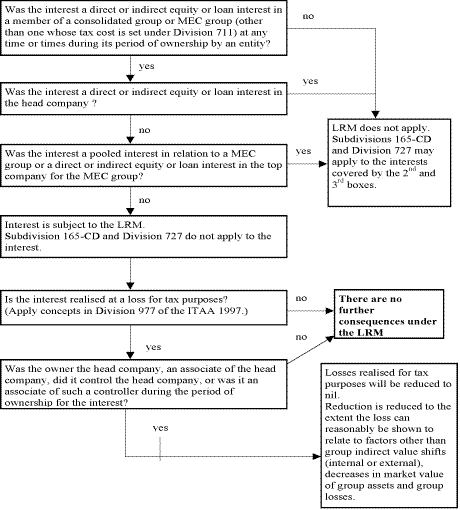
LIM and GVSR: minor amendments and technical corrections
11.170 The amendments contained in Schedule 26 in relation to the global method of valuing assets under the LIM are explained in the following table.
| Amended/inserted | Effect of amendment/insertion |
|---|---|
| ITAA 1997 | |
| Subsection 165-115ZD(4)
[Schedule 26, item 2] |
Ensures that the method statement deals with a case where the loss that would be realised on the interest is greater than or equal to the value removed from the company. The method statement does not currently do this, but the deficiency has no adverse consequences because of the reasonable adjustment tests in subsection 165-115ZB(6). This change does not therefore affect the practical operation of the law. |
| Paragraph 165-115ZD(5)(a)
[Schedule 26, item 3] |
The amendment clarifies the meaning of 'notional capital gain' and 'notional revenue gain' by reference to the definitions in Subdivision 165-CC of the ITAA 1997. |
| Subsection 165-115ZD(9)
[Schedule 26, item 4] |
The amendment inserts new subsection 165-115ZD(9). It ensures that if non-overlapping amounts of loss would arise under the capital gains and the revenue provisions on realisation of an equity or debt interest, the total of those amounts is taken into account in determining the amount of any adjustment to be made under section 165-115ZD. |
| IT(TP) Act 1997 | |
| Subsection 165-115ZD(5)
[Schedule 26, item 7] |
The amendment inserts new subsection 165-115ZD(5). It provides that if separate amounts of loss would arise under both the capital gains and the revenue provisions on realisation of an equity or debt interest, the total of those amounts is taken into account in determining the amount of any adjustment to be made under section 165-115ZD. |
11.171 In addition to the amendments explained in the table, there are minor amendments to subsection 165-115ZD(1) of the ITAA 1997 and subsection 165-115ZD(1) and paragraph 165-115ZD(2)(a) of the IT(TP) Act 1997 to facilitate those amendments. [Schedule 26, items 1, 5 and 6]
11.172 The amendments contained in Schedule 25 in relation to the general value shifting regime are explained in the following table:
| Amended/inserted | Effect of amendment |
|---|---|
| ITAA 1997 | |
| Section 136-10
[Schedule 25, items 1 to 3] |
The amendments remove a reference to the previous value shifting provisions from the table in section 136-10 and add a reference to CGT event K8, relating to the new direct value shifting rules |
| Subsection 727-715(3A)
[Schedule 25, item 8] |
The amendment inserts new subsection 727-715(3A). Under new subsection 727-715(3A), if an equity or debt interest is trading stock or a revenue asset, the tax value used to determine whether the exception applies is the greater of its adjustable value as a CGT asset and its adjustable value as trading stock or a revenue asset. |
| Paragraph 727-715(4)(b)
[Schedule 25, item 9] |
Amended paragraph 727-715(4)(b) makes it clear that if the threshold is worked out after the start of the income year, the relevant time is when the group relationship was last established between the entities. Normally, the threshold for determining whether the exception in section 727-715 applies is worked out at the start of the income year in which the interest is realised. However, if the entities providing and receiving the services entered into a group relationship after the start of the year, the threshold is worked out when the group relationship began. |
| Subsection 727-800(6A)
[Schedule 25, item 10] |
The amendment inserts new subsection 727-800(6A). When the adjustable values of interests in an entity that loses value in a value shift are reduced, a complementary adjustment may be available under section 727-800 to the adjustable values of interests in an entity that gains value. The amounts of adjustments under this section are related to the reductions made to adjustable values of interests in the losing entity. Since there may be different adjustments for interests in the losing entity for different purposes (to their cost bases, reduced cost bases, and adjustable values as revenue assets or as trading stock), new subsection 727-800(6A) specifies which adjustments are relevant in calculating the complementary adjustments available. |
| IT(TP) Act 1997 | |
| Subsection 723-1(1)
[Schedule 25, item 11] |
The amendment revises subsection 723-1(1) by adopting the same terminology as is used in Division 723 of the ITAA 1997. The change has no effect on its operation. |
11.173 There are also minor amendments in Schedule 25 to correct a number of references to section 104-250; to omit a superfluous word; and to remove an asterisk from a term (loan) which is not currently defined in the ITAA 1997 and is intended to have its ordinary meaning. [Schedule 25, items 4 to 7]
11.174 The allocable cost rules in subsection 705-65(3) are also amended to ensure that any adjustment that would have been required to a realised loss on a membership interest just before the joining time (or under the rules in section 705-75 on an intra-group debt interest at that time) is taken into account for the purposes of subsection 705-65(1) and section 705-75 as a reduction to reduced cost base. [Schedule 7, item 7]
11.175 Schedule 7 also makes a number of amendments to the dictionary for newly defined terms and to modify the scope of existing definitions. [Schedule 7, items 14 to item 29]
Application and transitional provisions
11.176 Amendments addressing interactions with consolidation rules and other rules (Schedule 4) apply from the start of consolidations regime (1 July 2002).
11.177 Amendments to the loss integrity rules in Subdivision 165-CD - global method - apply from the commencement of those rules (at or after 1.00 pm Australian Capital Territory time on 11 November 1999). [Schedule 26, item 8]
11.178 Amendments to the value shifting provisions - apply from the start of the various GVSR Divisions affected (generally, 1 July 2002). [Schedule 25, item 12]
Consequential amendments
11.179 There are no consequential amendments.
Copyright notice
© Australian Taxation Office for the Commonwealth of Australia
You are free to copy, adapt, modify, transmit and distribute material on this website as you wish (but not in any way that suggests the ATO or the Commonwealth endorses you or any of your services or products).

